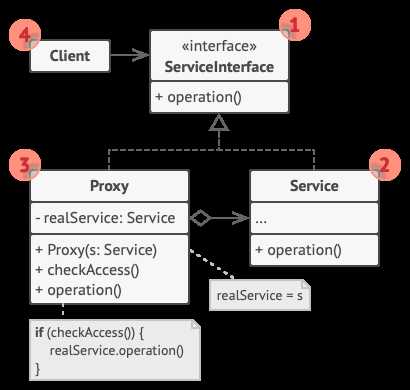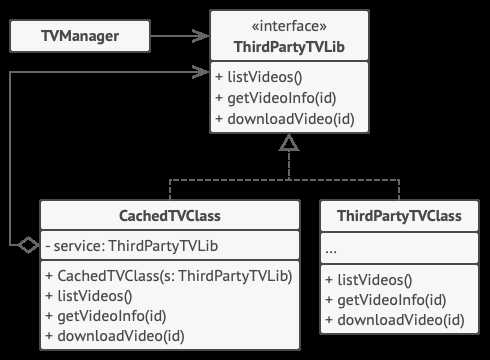标签:课程 一个 概述 onclick tproxy opera link nta 添加
概述
场景

结构

示例1
client.cpp

1 class ISubject{ 2 public: 3 virtual void process(); 4 }; 5 6 class RealSubject: public ISubject{ 7 public: 8 virtual void process(){ 9 //.... 10 } 11 }; 12 13 class ClientApp{ 14 15 ISubject* subject; 16 17 public: 18 19 ClientApp(){ 20 subject=new RealSubject(); 21 } 22 23 void DoTask(){ 24 //... 25 subject->process(); 26 27 //.... 28 } 29 };
proxy.cpp

1 class ISubject{ 2 public: 3 virtual void process(); 4 }; 5 6 //Proxy的设计 7 class SubjectProxy: public ISubject{ 8 9 10 public: 11 virtual void process(){ 12 //对RealSubject的一种间接访问 13 //.... 14 } 15 }; 16 17 class ClientApp{ 18 19 ISubject* subject; 20 21 public: 22 23 ClientApp(){ 24 subject=new SubjectProxy(); 25 } 26 27 void DoTask(){ 28 //... 29 subject->process(); 30 31 //.... 32 } 33 };
示例2

1 #include <string> 2 #include <iostream> 3 using namespace std; 4 5 // 定义接口 6 class Interface{ 7 public: 8 virtual void Request() = 0 ; 9 }; 10 // 真实类 11 class RealClass:public Interface{ 12 public: 13 virtual void Request(){ 14 cout<<"真实的请求"<<endl; 15 } 16 }; 17 // 代理类 18 class ProxyClass:public Interface{ 19 private: 20 RealClass* m_realClass; 21 public: 22 virtual void Request(){ 23 m_realClass = new RealClass(); 24 m_realClass->Request(); 25 delete m_realClass; 26 } 27 }; 28 // 客户端 29 int main(){ 30 ProxyClass* test = new ProxyClass(); 31 test->Request(); 32 return 0; 33 }
>>真实的请求
示例3


1 // 远程服务接口。 2 interface ThirdPartyTVLib is 3 method listVideos() 4 method getVideoInfo(id) 5 method downloadVideo(id) 6 7 // 服务连接器的具体实现。该类的方法可以向腾讯视频请求信息。请求速度取决于 8 // 用户和腾讯视频的互联网连接情况。如果同时发送大量请求,即使所请求的信息 9 // 一模一样,程序的速度依然会减慢。 10 class ThirdPartyTVClass implements ThirdPartyTVLib is 11 method listVideos() is 12 // 向腾讯视频发送一个 API 请求。 13 14 method getVideoInfo(id) is 15 // 获取某个视频的元数据。 16 17 method downloadVideo(id) is 18 // 从腾讯视频下载一个视频文件。 19 20 // 为了节省网络带宽,我们可以将请求结果缓存下来并保存一段时间。但你可能无 21 // 法直接将这些代码放入服务类中。比如该类可能是第三方程序库的一部分或其签 22 // 名是`final(最终)`。因此我们会在一个实现了服务类接口的新代理类中放入 23 // 缓存代码。当代理类接收到真实请求后,才会将其委派给服务对象。 24 class CachedTVClass implements ThirdPartyTVLib is 25 private field service: ThirdPartyTVLib 26 private field listCache, videoCache 27 field needReset 28 29 constructor CachedTVClass(service: ThirdPartyTVLib) is 30 this.service = service 31 32 method listVideos() is 33 if (listCache == null || needReset) 34 listCache = service.listVideos() 35 return listCache 36 37 method getVideoInfo(id) is 38 if (videoCache == null || needReset) 39 videoCache = service.getVideoInfo(id) 40 return videoCache 41 42 method downloadVideo(id) is 43 if (!downloadExists(id) || needReset) 44 service.downloadVideo(id) 45 46 // 之前直接与服务对象交互的 GUI 类不需要改变,前提是它仅通过接口与服务对 47 // 象交互。我们可以安全地传递一个代理对象来代替真实服务对象,因为它们都实 48 // 现了相同的接口。 49 class TVManager is 50 protected field service: ThirdPartyTVLib 51 52 constructor TVManager(service: ThirdPartyTVLib) is 53 this.service = service 54 55 method renderVideoPage(id) is 56 info = service.getVideoInfo(id) 57 // 渲染视频页面。 58 59 method renderListPanel() is 60 list = service.listVideos() 61 // 渲染视频缩略图列表。 62 63 method reactOnUserInput() is 64 renderVideoPage() 65 renderListPanel() 66 67 // 程序可在运行时对代理进行配置。 68 class Application is 69 method init() is 70 aTVService = new ThirdPartyTVClass() 71 aTVProxy = new CachedTVClass(aTVService) 72 manager = new TVManager(aTVProxy) 73 manager.reactOnUserInput()
示例4

1 #include <iostream> 2 /** 3 * The Subject interface declares common operations for both RealSubject and the 4 * Proxy. As long as the client works with RealSubject using this interface, 5 * you‘ll be able to pass it a proxy instead of a real subject. 6 */ 7 class Subject { 8 public: 9 virtual void Request() const = 0; 10 }; 11 /** 12 * The RealSubject contains some core business logic. Usually, RealSubjects are 13 * capable of doing some useful work which may also be very slow or sensitive - 14 * e.g. correcting input data. A Proxy can solve these issues without any 15 * changes to the RealSubject‘s code. 16 */ 17 class RealSubject : public Subject { 18 public: 19 void Request() const override { 20 std::cout << "RealSubject: Handling request.\n"; 21 } 22 }; 23 /** 24 * The Proxy has an interface identical to the RealSubject. 25 */ 26 class Proxy : public Subject { 27 /** 28 * @var RealSubject 29 */ 30 private: 31 RealSubject *real_subject_; 32 33 bool CheckAccess() const { 34 // Some real checks should go here. 35 std::cout << "Proxy: Checking access prior to firing a real request.\n"; 36 return true; 37 } 38 void LogAccess() const { 39 std::cout << "Proxy: Logging the time of request.\n"; 40 } 41 42 /** 43 * The Proxy maintains a reference to an object of the RealSubject class. It 44 * can be either lazy-loaded or passed to the Proxy by the client. 45 */ 46 public: 47 Proxy(RealSubject *real_subject) : real_subject_(new RealSubject(*real_subject)) { 48 } 49 50 ~Proxy() { 51 delete real_subject_; 52 } 53 /** 54 * The most common applications of the Proxy pattern are lazy loading, 55 * caching, controlling the access, logging, etc. A Proxy can perform one of 56 * these things and then, depending on the result, pass the execution to the 57 * same method in a linked RealSubject object. 58 */ 59 void Request() const override { 60 if (this->CheckAccess()) { 61 this->real_subject_->Request(); 62 this->LogAccess(); 63 } 64 } 65 }; 66 /** 67 * The client code is supposed to work with all objects (both subjects and 68 * proxies) via the Subject interface in order to support both real subjects and 69 * proxies. In real life, however, clients mostly work with their real subjects 70 * directly. In this case, to implement the pattern more easily, you can extend 71 * your proxy from the real subject‘s class. 72 */ 73 void ClientCode(const Subject &subject) { 74 // ... 75 subject.Request(); 76 // ... 77 } 78 79 int main() { 80 std::cout << "Client: Executing the client code with a real subject:\n"; 81 RealSubject *real_subject = new RealSubject; 82 ClientCode(*real_subject); 83 std::cout << "\n"; 84 std::cout << "Client: Executing the same client code with a proxy:\n"; 85 Proxy *proxy = new Proxy(real_subject); 86 ClientCode(*proxy); 87 88 delete real_subject; 89 delete proxy; 90 return 0; 91 }

参考
https://refactoringguru.cn/design-patterns/proxy
标签:课程 一个 概述 onclick tproxy opera link nta 添加
原文地址:https://www.cnblogs.com/cxc1357/p/12312807.html